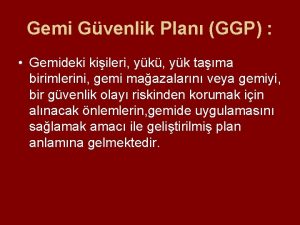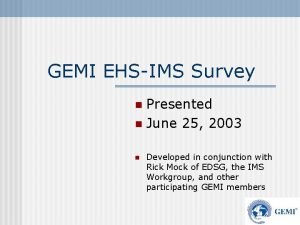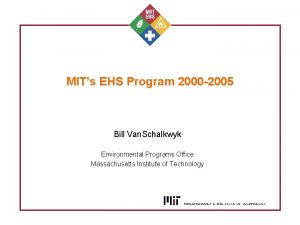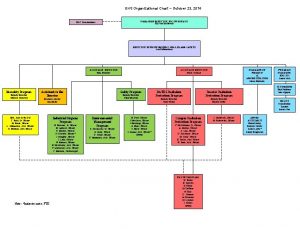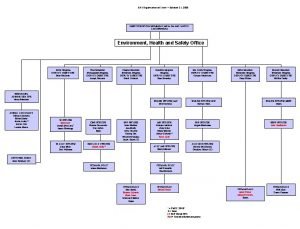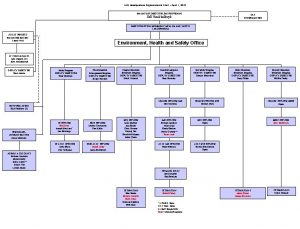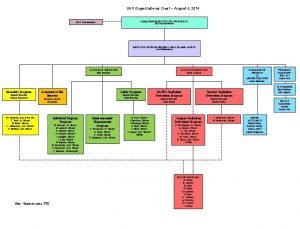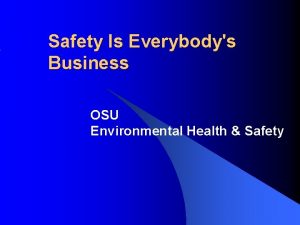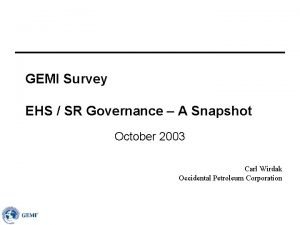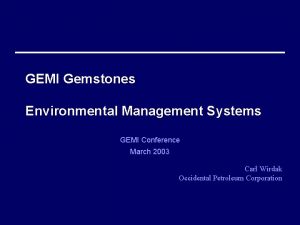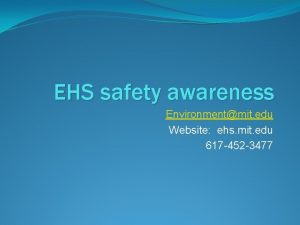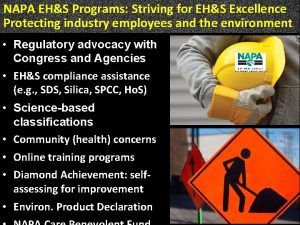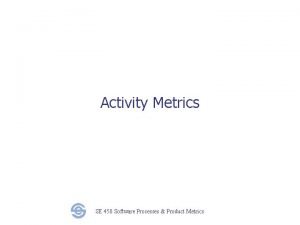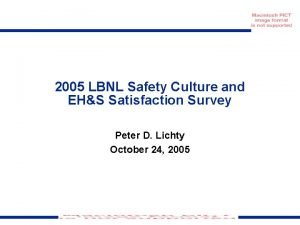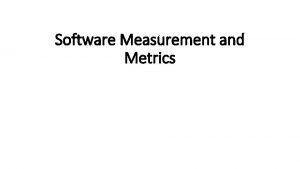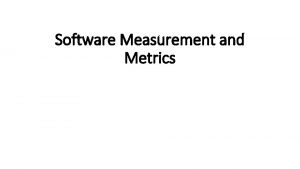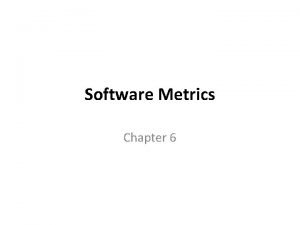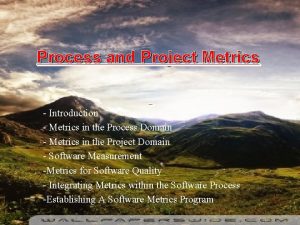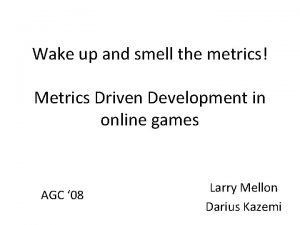GEMI Survey EHS Metrics and Processes January 2003























- Slides: 23

GEMI Survey EHS Metrics and Processes January 2003 Carl Wirdak Occidental Petroleum Corporation

Outline • Survey Recap • EHS Metrics • Metrics Process and Practice EHS Metrics & Processes 2

Survey Overview • Survey addresses the management of environment, health or safety (EHS) metrics and metrics processes that apply to a company’s business activities • Survey response rate ~60% – 21 companies responded to the survey – Not all companies completed all questions • Broad industry coverage • Thank you to all participants! EHS Metrics & Processes 3

Metrics Overview • Over 475 EHS metrics listed (about 23 per company) • Heavily weighted to environmental • Balance among internal measures EHS Metrics & Processes 4

Metrics Usage • Metrics used most often to assess organizational performance – “Are we doing what we set out to do? ” • Influencing key stakeholders (external) is important EHS Metrics & Processes 5

Topical Coverage • Focus is on the basics • Communicating environmental performance to external audience is key • More balanced message to internal audiences EHS Metrics & Processes 6

Leading / Lagging Indicators Most firms rely on lagging indicators for EHS metrics EHS Metrics & Processes 7

Quantitative Targets • Widespread use of quantitative targets • Nine GEMI companies have numeric targets on all internal EHS metrics EHS Metrics & Processes 8

Normalization • Almost all firms use normalized metrics • Greater use in communication of EHS metrics to external audiences • Man-hours, production units and revenue are the most common bases EHS Metrics & Processes 9

Update Frequency Internal EHS metrics updated more frequently than those reported externally EHS Metrics & Processes 10

Overview of Metrics Processes • Most companies do not have a problem with management support of the EHS metrics program • Most companies have documented their procedures for metrics practices • Few have calculated the costs associated with developing, collecting and reporting on EHS metrics, but… • Most expect to spend about the same as last year EHS Metrics & Processes 11

New Metrics - Practical Considerations d t an rt po Im re t n ta de si r po on Im C ot N ry Ve What steps do companies perform when developing new EHS metrics? Compare new metrics with existing or developing standards 62% 38% 0% Account for off-shore facility considerations / applicability 58% 42% 0% Involve key business unit, operational and line managers 52% 33% 14% Define internal measurement techniques and performance goals 48% 52% 0% Define reporting levels and responsibilities 48% 43% 10% Identify external benchmarks 29% 67% 5% Conduct pilot testing to confirm / validate data measurement 29% 52% 19% Conduct a cost / benefit analysis for rationalizing new metric 19% 57% 24% Perform a formalized stakeholder needs evaluation 19% 52% 29% 5% 55% 40% Incorporate into personnel evaluations and compensation systems EHS Metrics & Processes 12

New Metrics – “Value-Added” Factors d t an rt po Im re t n ta de si r po on Im C ot N ry Ve Top 10 “value-added” factors companies consider when assessing an EHS metric Can be used to demonstrate progress towards goals and objectives 76% 24% 0% Can be used to motivate a desired behavior or change 71% 29% 0% Easy to measure / data collection is at a reasonable cost 71% 29% 0% Can be clearly stated / is easily understood by management 67% 33% 0% Shows strengths and weaknesses of business or EHS processes 48% 43% 10% Reflects risk associated with operational / EHS activities 48% 43% 10% Has strong linkage to strategy and objectives 43% 52% 5% Can be benchmarked 33% 62% 5% Potential for improving company’s financial return 29% 62% 10% Shows tie between EHS, operational, and management performance 29% 62% 10% EHS Metrics & Processes 13

New Metrics – “Value-Added” Factors d t an rt po Im re t n ta de si r po on Im C ot N ry Ve Less popular factors companies consider when assessing the “value-added” by an EHS metric Required anyway for legal / regulatory reporting 29% 48% 24% Ability to improve the "balance" with the existing set of metrics 24% 52% 24% Value as a prediction of future trends 24% 48% 29% Incorporated in existing or developing standards (e. g. , GRI) 24% 43% 33% Can show economic value-added across the value/supply chain 24% 38% To track record of resolving stakeholder requirements or issues 14% 67% 19% Can be normalized on a meaningful basis 10% 67% 24% Concern that data can be artificially "manipulated“ to hide true performance 10% 57% 33% EHS Metrics & Processes 14

Data Sources Common • Regulatory reports • Audit results / findings • Computerized MIS • • • Uncommon Monitoring / measuring equipment Management systems reviews Inventory and production records External reports and studies Interviews / discussions • Quality management systems • Financial and accounting systems EHS Metrics & Processes 15

Data Capture & Validation Capture Essentially a manual process 0% Some automation but more of a manual process 10% A combination of electronic and manual processes 40% More electronic and automated than manual 40% Fully integrated and on-line MIS process 10% Validation Via audit programs 71% Formal internal data checking processes 71% Searches of regulatory agency or 3 rd-party databases 38% Via an independent, 3 rd-party consultant 10% No validation practices implemented EHS Metrics & Processes 5% 16

Metrics Reporting and Analysis • EHS metrics are reported to management in a variety of ways • Fewer than half (~40%) of the survey respondents reported use of a “Balanced Scorecard” approach to managing overall business goals, but all companies that use it include EHS metrics in the mix EHS Metrics & Processes 17

Performance Evaluation Im po Co n rta nt sid No t Im ere d po rta nt Against defined performance goals and objectives 67% 24% 10% Determine effectiveness of EHS management systems 57% 38% 5% To better manage business costs / risks 57% 33% 10% Business unit / division / facility performance ranking 40% 20% To support initiatives for performance improvement 38% 57% 5% Individual manager's job performance 24% 48% 29% Evaluating resource (budget and staffing) needs 14% 76% 10% 5% 45% 50% To determine economic valueadded of EHS activities EHS Metrics & Processes 18

EHS Performance Feedback • EHS metrics are used by all companies as a tool to improve company performance • When a metric indicates sub-par performance, >80% of companies do further analysis • Further analysis leads to performance improvement about 67% of the time EHS Metrics & Processes 19

Continuous Improvement of Metrics What factors do companies consider when assessing how to improve EHS metrics? Importance High Mid Low Ability to improve company performance 86% 10% 5% 0% 0% Quality, consistency or accuracy of metric 57% 33% 10% 0% 0% Linkage with corporate objectives 52% 33% 10% 0% 5% Relevance to management needs 29% 57% 5% 0% 10% Relevance to stakeholders 29% 33% 5% 5% Timeliness of information reported 24% 38% 24% 14% 0% Ease of interpretation 14% 48% 29% 10% 0% 5% 24% 33% 19% Promotes cooperation between business units or departments EHS Metrics & Processes 20

Metrics Turnover Number of companies 20 Dropped 15 Added 10 5 0 0 -10 11 -20 21 -30 31 -40 Annual turnover percentage EHS Metrics & Processes 41 -50 21

Conclusions • There are many different metrics in use • Differences exist between metrics that are used internally and those that are communicated externally • EHS metrics are linked to the business • The use of lagging indicators far outweighs the use of leading indicators • Applying quantitative targets to metrics is common practice • Generally, metrics processes are sophisticated and mature • Companies continue to search for better metrics • Questions /comments? EHS Metrics & Processes 22

Future Benchmarking Study Ideas • Development of goals and their relation to the metrics • The use of cost accounting practices (ABC, TCA) within EHS and how it relates in the various business aspects, operations, product development, etc • The use of the Balanced Scorecard for EHS and how it is aligned with the business's use of the scorecard • International regulatory tracking & influence • Climate change approaches • Audit process and management • Management systems implementation • How, by whom and when companies conduct independent verifications of their metrics systems • A study on GRI reporting, such as to what extent are member companies complying EHS Metrics & Processes 23
 Dümen çeşitleri
Dümen çeşitleri Teknenin omurga posta ve kemer'e
Teknenin omurga posta ve kemer'e şgg
şgg Suveys gemi
Suveys gemi Concurrent in os
Concurrent in os 叫叫abcd
叫叫abcd Ehs mit
Ehs mit Sap ehs online training
Sap ehs online training Ehs penn state
Ehs penn state Mit ehs training
Mit ehs training Ehs ucsb
Ehs ucsb Ehs organization chart
Ehs organization chart Ehs organizational structure
Ehs organizational structure Ehs organizational structure
Ehs organizational structure Maximo anywhere training
Maximo anywhere training Yale ehs integrator
Yale ehs integrator Sap ehs training
Sap ehs training Oregon state ehs
Oregon state ehs Ehs organization chart
Ehs organization chart Ehs uf
Ehs uf Osu environmental health and safety
Osu environmental health and safety Lincoln university police
Lincoln university police Huawei ehs exam answers
Huawei ehs exam answers Ehs flexisched
Ehs flexisched


